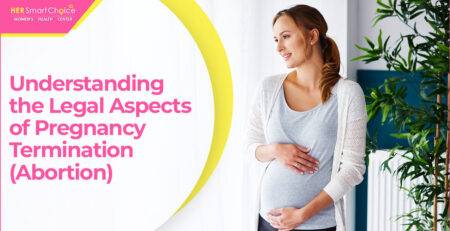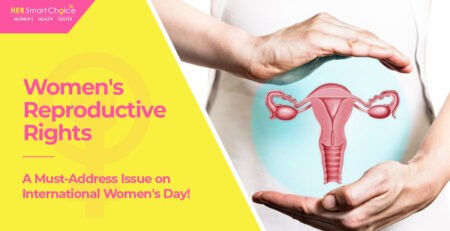Abnormal Uterine Bleeding Treatment: Comprehensive Options and Patient Guidance

Abnormal uterine bleeding (AUB) disrupts daily life for up to one-third of women, leading to anemia, fatigue, and fertility concerns. This guide from Her Smart Choice delivers clear definitions, diagnostic pathways, medical and surgical interventions, cause-specific strategies, long-term management plans, non-hormonal alternatives, and decision-making frameworks. You will learn how healthcare providers diagnose AUB, compare hormonal and non-hormonal therapies, evaluate surgical options like endometrial ablation and hysterectomy, tailor treatment when fibroids or polyps are present, adopt lifestyle adjustments, explore complementary remedies, and choose the best intervention based on severity, fertility goals, and personal preference.
Follow Us!
What Is Abnormal Uterine Bleeding and How Is It Diagnosed?
Abnormal uterine bleeding is bleeding that falls outside regular cycle length, flow, or timing because of structural or hormonal disruptions in the uterus, and diagnosing it early prevents complications such as severe anemia.
What Defines Abnormal Uterine Bleeding?
Abnormal uterine bleeding occurs when menstrual bleeding exceeds 80 mL per cycle, lasts longer than seven days, or occurs between cycles due to irregular shedding of the endometrium. It includes heavy menstrual bleeding (menorrhagia), intermenstrual spotting, and prolonged periods. For instance, bleeding that soaks more than one pad an hour for several hours signals menorrhagia, while spotting before ovulation indicates intermenstrual bleeding. Understanding these patterns clarifies when to seek further evaluation.
Exploring underlying causes clarifies how structural and hormonal factors alter normal menstrual physiology.
What Are the Common Causes of Abnormal Uterine Bleeding?
Abnormal uterine bleeding stems from a range of conditions affecting the endometrium or systemic hormones.
- Hormonal imbalance disrupts the estrogen-progesterone cycle and leads to irregular shedding.
- Uterine fibroids are benign smooth-muscle tumors that enlarge the uterine cavity and cause heavy flow.
- Endometrial polyps are mucosal overgrowths that provoke intermenstrual spotting.
- Polycystic ovary syndrome (PCOS) causes anovulation and unpredictable bleeding.
- Endometrial hyperplasia or cancer alters lining architecture and may present as post-menopausal bleeding.
These key etiologies guide targeted treatment instead of one-size-fits-all approaches.
How Is Abnormal Uterine Bleeding Diagnosed?

Diagnosis relies on imaging, laboratory tests, and endometrial sampling to identify structural and systemic causes.
| Entity | Attribute | Value & Evidence |
|---|---|---|
| Pelvic Examination | Findings | Enlarged uterus (fibroids), cervical lesions, adnexal masses |
| Transvaginal Ultrasound | Sensitivity | Detects polyps, fibroids, endometrial thickening (>11 mm post-menopause) |
| Endometrial Biopsy | Diagnostic Yield | Identifies hyperplasia, malignancy, endometritis |
| Hysteroscopy | Accuracy | Direct visualization removes polyps and obtains targeted biopsies |
| Blood Tests | Evaluations | CBC for anemia, TSH for thyroid, coagulation profile for bleeding disorders |
These diagnostic methods pinpoint the source of bleeding and shape effective treatment strategies.
Diagnosis of AUB
Diagnosis of abnormal uterine bleeding (AUB) relies on imaging, laboratory tests, and endometrial sampling to identify structural and systemic causes. Transvaginal ultrasound is used to detect polyps, fibroids, and endometrial thickening.
Munro, M. G., et al. “FIGO classification system for causes of abnormal uterine bleeding in the reproductive years.” International Journal of Gynecology & Obstetrics (2011)
This source supports the diagnostic methods used to identify the causes of AUB.
When Should You Seek Medical Attention for Abnormal Uterine Bleeding?
Recognizing warning signs ensures prompt intervention for heavy or irregular bleeding.
- Sudden soaking of one pad or tampon per hour for consecutive hours
- Passing clots larger than a quarter in diameter
- Symptoms of anemia such as dizziness, palpitations, or severe fatigue
- Bleeding after menopause or between cycles in reproductive years
- Signs of infection: fever, foul vaginal odor, pelvic pain
Prompt evaluation reduces risks of anemia, infection, and underlying serious conditions.
What Medical Treatments Are Available for Abnormal Uterine Bleeding?
How Do Hormonal Therapies Treat Abnormal Uterine Bleeding?
Hormonal therapies regulate the menstrual cycle by balancing estrogen and progesterone to stabilize the endometrium.
- Combined Oral Contraceptives thin the lining and reduce flow by 35–50 percent.
- Progestin-Only Pills support secretory endometrium and prevent hyperplasia.
- Hormonal IUD (Levonorgestrel) delivers local progestin to thin the lining and induce amenorrhea in up to 60 percent of users.
- GnRH Agonists suppress ovarian steroidogenesis and shrink fibroids before surgery.
These approaches improve hemoglobin levels and reduce the need for invasive procedures.
Hormonal Therapies for AUB
Combined oral contraceptives are often used to treat abnormal uterine bleeding (AUB) because they thin the uterine lining and reduce blood flow by 35–50 percent. Progestin-only pills are also used to support the endometrium and prevent hyperplasia.
American College of Obstetricians and Gynecologists, “Abnormal Uterine Bleeding” (2018)
This source supports the use of hormonal therapies in managing AUB.
What Non-Hormonal Medications Help Manage Heavy Menstrual Bleeding?
Non-hormonal drugs target pain and bleeding pathways without altering hormonal balance.
- Nonsteroidal Anti-Inflammatory Drugs (NSAIDs) inhibit prostaglandins to reduce flow by 20–50 percent and alleviate cramping.
- Tranexamic Acid blocks fibrinolysis to decrease bleeding volume by up to 60 percent.
- Desmopressin enhances platelet function in women with bleeding disorders.
How Are Specific Conditions like PCOS and Thyroid Disorders Treated in AUB?
Addressing systemic disorders corrects menstrual irregularities and bleeding patterns.
- In PCOS, weight management and insulin sensitizers restore ovulation and normalize cycles.
- For hypothyroidism, levothyroxine replacement resolves menorrhagia and irregular periods.
- Bleeding disorders like von Willebrand disease respond to desmopressin or factor concentrates.
Targeted management of underlying disease prevents recurrent AUB and preserves fertility.
What Are the Benefits and Side Effects of Hormonal Treatments?
Hormonal treatments offer reliable cycle control but carry risk profiles that require evaluation.
| Entity | Attribute | Value / Notes |
|---|---|---|
| Combined Pill | Efficacy | Reduces blood loss by 35–50 percent |
| Contraindications | History of thromboembolism, migraine with aura, smoking >35 | |
| Progestin IUD | Duration | Effective up to 5 years; amenorrhea in 20–60 percent of users |
| Side Effects | Spotting, breast tenderness, ovarian cysts | |
| GnRH Agonists | Use Cases | Pre-surgical fibroid reduction |
| Risks | Bone density loss; add-back therapy recommended after 6 months |
What Surgical Options Exist for Treating Abnormal Uterine Bleeding?

How Does Endometrial Ablation Work for Heavy Bleeding?
Endometrial ablation destroys the uterine lining to dramatically reduce or stop bleeding through thermal or radiofrequency energy.
- Technique: Hysteroscopic resection, roller-ball coagulation, cryoablation, or thermal balloon.
- Recovery: Outpatient procedure with cramping and light spotting for 1–2 weeks.
- Outcome: 80 percent of patients report lighter periods; 10 percent achieve amenorrhea.
- Risks: Infection, uterine perforation, future pregnancy complications.
Candidates must have completed childbearing and understand the impact on fertility.
Surgical Options for AUB
Endometrial ablation is a surgical procedure that destroys the uterine lining to reduce or stop bleeding. Approximately 80 percent of patients report lighter periods after the procedure, and about 10 percent achieve amenorrhea.
National Institutes of Health, “Endometrial Ablation” (2022)
This citation provides information on the effectiveness of endometrial ablation in treating heavy menstrual bleeding.
When Is Hysterectomy Recommended for Abnormal Uterine Bleeding?
Hysterectomy removes the uterus, providing definitive resolution of AUB in appropriate patients.
- Indicated for severe bleeding unresponsive to other treatments or when malignancy is confirmed.
- Approaches include vaginal, abdominal, or laparoscopic routes.
- Recovery spans 4–6 weeks with significant improvement in quality of life.
- Risks encompass surgical complications, hormonal changes if ovaries removed, and impact on pelvic support.
Hysterectomy offers permanent relief but requires thorough counseling on long-term effects.
What Role Do Hysteroscopy and Polyp or Fibroid Removal Play?
Minimally invasive hysteroscopy allows direct removal of intrauterine lesions under visualization.
- Polypectomy excises polyps causing spotting or heavy flow.
- Myomectomy resects fibroids to preserve fertility and restore uterine anatomy.
- Benefits include targeted excision, rapid recovery, and minimal scarring.
Lesion removal often resolves bleeding without the need for more extensive surgery.
How Is Dilation and Curettage (D&C) Used in Diagnosis and Treatment?
Dilation and curettage combines uterine sampling with removal of retained tissue to both diagnose and treat bleeding.
- Diagnostic Use: Obtains endometrial tissue for histopathology.
- Therapeutic Use: Clears polypoid or hyperplastic tissue, reducing bleeding acutely.
- Limitations: Bleeding often recurs unless underlying cause is addressed.
D&C offers immediate relief but typically complements further medical or surgical therapy.
Frequently Asked Questions
Making certain lifestyle adjustments can significantly help manage abnormal uterine bleeding (AUB). Maintaining a healthy weight through balanced nutrition and regular exercise can regulate hormonal levels, which may alleviate symptoms. Additionally, managing stress through mindfulness practices or yoga can also be beneficial. It’s important to avoid smoking and limit alcohol intake, as these can exacerbate bleeding issues. Regular check-ups with a healthcare provider at Her Smart Choice can help monitor symptoms and adjust lifestyle changes as needed for optimal management of AUB.
Complementary therapies may provide additional relief for those experiencing abnormal uterine bleeding. Acupuncture has been shown to help regulate menstrual cycles and reduce pain associated with heavy bleeding. Herbal remedies, such as ginger and turmeric, may also have anti-inflammatory properties that can help. However, it’s crucial to consult with a healthcare provider before starting any complementary therapies to ensure they are safe and appropriate for your specific condition and do not interfere with other treatments.
Abnormal uterine bleeding can impact fertility, particularly if it is caused by underlying conditions such as polycystic ovary syndrome (PCOS) or uterine fibroids. These conditions can disrupt ovulation and the overall menstrual cycle, making it more challenging to conceive. Additionally, heavy bleeding can lead to anemia, which may affect overall health and fertility. It is essential for women experiencing AUB and planning to conceive to work closely with their healthcare provider at Her Smart Choice to address any underlying issues and optimize their reproductive health.
Long-term management of abnormal uterine bleeding (AUB) often involves a combination of medical treatment, lifestyle changes, and regular monitoring. Patients may need to continue hormonal therapies or non-hormonal medications to manage symptoms effectively. Regular follow-ups with a healthcare provider are crucial to assess the effectiveness of treatments and make necessary adjustments. Additionally, maintaining a healthy lifestyle, including diet and exercise, can help manage symptoms and improve overall well-being. Education about the condition and its management is also vital for empowering patients.
During the diagnostic process for abnormal uterine bleeding, patients can expect a thorough evaluation that includes a detailed medical history and physical examination. Healthcare providers may recommend imaging tests, such as transvaginal ultrasound, to visualize the uterus and identify any structural abnormalities. Blood tests may also be conducted to check for anemia or hormonal imbalances. In some cases, endometrial biopsy or hysteroscopy may be performed to obtain tissue samples for further analysis. This comprehensive approach helps pinpoint the cause of AUB and guides appropriate treatment options.
Yes, abnormal uterine bleeding can sometimes indicate a more serious underlying condition, such as endometrial hyperplasia or cancer, especially in postmenopausal women. Other serious conditions, like uterine fibroids or polyps, can also lead to significant bleeding. It is essential to seek medical attention if you experience heavy bleeding, bleeding between periods, or any other unusual symptoms. Early diagnosis and intervention are crucial for addressing potential complications and ensuring appropriate treatment.
Conclusion
Understanding and addressing abnormal uterine bleeding (AUB) is crucial for improving women’s health and quality of life. By exploring various treatment options, including hormonal therapies, non-hormonal medications, and surgical interventions, patients can find tailored solutions that meet their individual needs. Regular consultations with healthcare providers at Her Smart Choice ensure effective management and monitoring of symptoms. Take the first step towards better menstrual health by scheduling a consultation today.
Follow Us!










